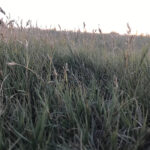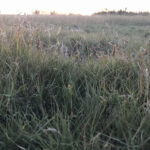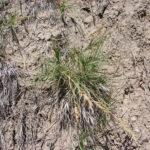Alkali Saltgrass
Distichlis spicata
General Description
Alkali saltgrass or saltgrass is a native perennial grass, found in saline and alkaline soils across western Canada. It forms a dense, low growing mat with rhizomes (below ground) and stolons (above ground). Salt grass leaves come off short stems at a 45 degree angle. The leaves are 1-3.5 mm wide, smooth or soft-hairy to stiff-hairy on the upper surface. Seed heads are often present.
Type
Native grass.
Origin
Native to North America. Found around saline uplands and lowlands.
Longevity
Long-lived.
Use
Reclamation, pasture.
Optimal Time of Use
Summer, fall. Saltgrass is used primary in the reclamation of dry and wet saline areas. Graze salt grass in the fall to avoid hoof damage to the sod. In native stands, salt grass is grazed as the secondary species in the stand.
Recovery After Use
Saltgrass withstands light grazing once per year.
Palatability/Nutritional Value
Saltgrass is seldom grazed if other grasses are available as it is a less preferred, secondary species by cattle and horses. It is noted to have fair nutritional value.
Annual Precipitation min/max (mm)
127mm / 1778mm
Drought Tolerance
Moderate to high tolerance.
Flooding Tolerance
Saltgrass requires 2-5 weeks of spring flooding and/or wet soils throughout the growing season. Intermittent moist periods are favored, however it is uniquely adapted to be drought tolerant and survive through long dry periods.
Winter Hardiness
Excellent hardiness.
Soil Texture Preference
Salt grass will only grow on saline or alkaline soils with specific moisture regime. It is adapted to all soil zones.
Erosion Control
In moist saline areas, salt grass sod is useful in the prevention of water erosion.
Salinity Tolerance
Excellent tolerance.
Acidity Tolerance
Not tolerant of acidic soils.
Alkalinity Tolerance
Good tolerance.
Seeds per kg
1,143,000 seeds/kg (519,000 seeds/lb)
Suggested Mixtures
Saline tolerant native grasses.
Ease of Establishment
Saltgrass seed is not commonly available. Establishment from seed is best under hot, moist conditions. Saltgrass can be grown from rhizome (root) cuttings that are planted shallow in warm, moist conditions. This is the most common and easier method of establishment.
Competitiveness
Saltgrass forms a thick sod.
Management Considerations
Graze late in the season to maintain plant vigor and reduce hoof damage. Saltgrass is a low growing native grass for saline areas.
Saskatchewan Dryland Forage Species Adaptation Tool, E-Flora BC Atlas, USDA Plants Database
Alkali saltgrass is commonly found in plant communities on Solonetzic soils (high soduium) or near salt producing closed basin ponds and surrounding flats in the Bunchgrass and Interior Douglas-fir zones in the southern part of the region. Suitability is limited to these site types.
Alkali saltgrass is commonly found in plant communities on Solonetzic soils (high soduium) or near salt producing closed basin ponds and surrounding flats in the Bunchgrass, Ponderosa Pine and Interior Douglas-fir zones. Suitability is limited to these sites.


